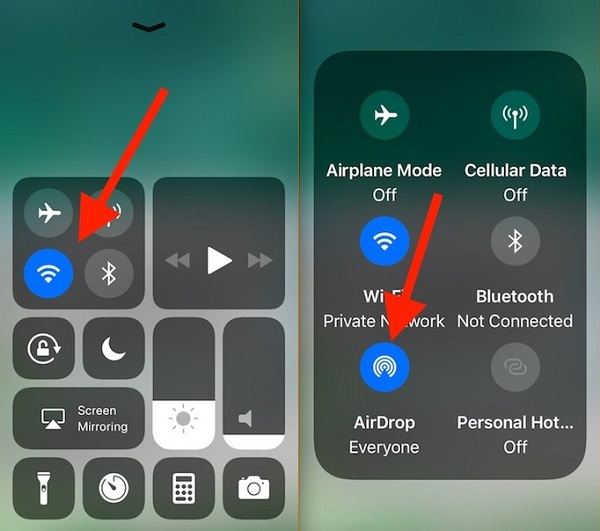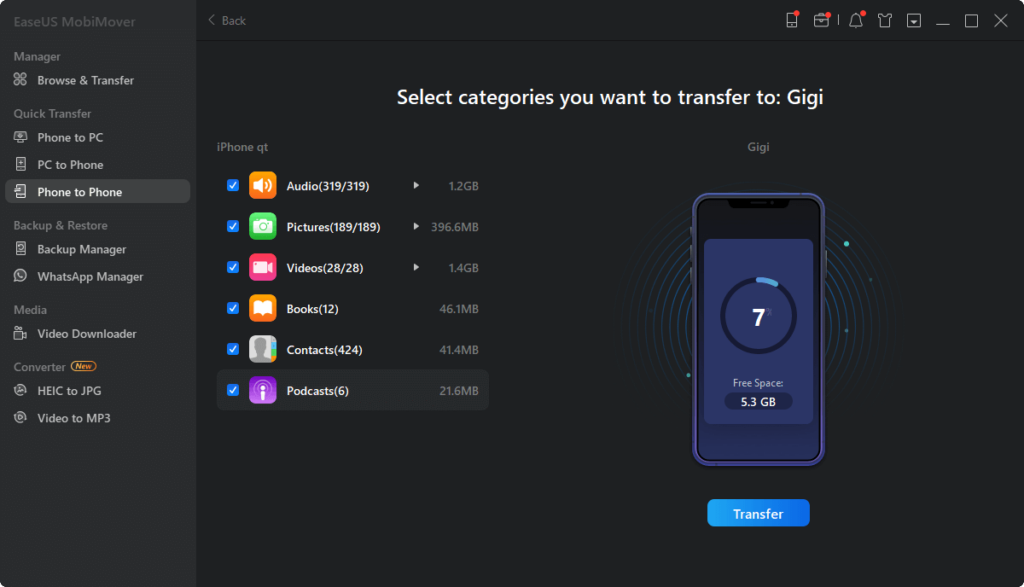You may share media files, contacts, and more via Apple’s built-in file-sharing tool, AirDrop, between any two AirDrop-enabled devices (iPhone, iPad, iPod Touch, and Mac). Because it is WiFi and Bluetooth enabled, it allows for wireless data transfer.
AirDrop is a great way to communicate films and photographs between iOS devices, including the iPhone and the Mac.
iPhone AirDrop: How To Enable It
Turning on AirDrop on an iPhone is a breeze. However, depending on whatever iPhone model you’re using, you may need to take a slightly different set of steps to activate AirDrop. Just select your iPhone’s model and then follow the instructions to activate AirDrop.
Launch AirDrop on iPhone X :
Step 1: You may access “Control Center” on your iPhone by swiping down from the top right corner of the screen.
Step 2: You should hold down the network card while pressing it.
Step 3: Wi-Fi and Bluetooth can be activated with a single tap. Select “Contacts Only” > “Everyone” after touching and holding the AirDrop icon. When using AirDrop, you can choose to make your device visible exclusively to people in your contact list or to all nearby Apple devices.
Read More: How to Install and Operate Chromecast on a Laptop or Computer?
Activate AirDrop on iPhone 8:

Step 1: With an iPhone, the “Control Center” can be accessed by swiping up from the bottom of the screen.
Step 2: Initiate the network configuration by pressing the card.
Step 3: Wi-Fi and Bluetooth can be activated with a single tap. After that, keep the AirDrop button pressed. Just select “Contacts Only” or “Everyone” depending on who needs to see it.
Invoking AirDrop Using The iPhone’s Settings Menu
AirDrop can be activated or deactivated in the Settings app as well as in Control Center:
Step 1: Choose “General” from the “Settings” menu.
Step 2: Select “Contacts Only” or “Everyone” under the “AirDrop” menu.
Setting Up Your iPhone For AirDrop
Simply tap “Receive Off” to disable AirDrop on your Apple device.
iPhone AirDrop Tutorial
After enabling AirDrop on both ends of the connection, you can send and receive files wirelessly. Make sure the receiver is close by and within Bluetooth or Wi-Fi range.
Step 1: You must first access the app on the source device that has the item you wish to share.
Step 2: Simply choose the file(s) you want to share and then hit the “Share” button.
Step 3: Select “AirDrop,” then tap the contact you wish to send files to.
Step 4: When prompted, select “Accept” on the receiving device to begin downloading the contents.
AirDrop: How To Enable It on A Mac
Since AirDrop is compatible with Mac, you can use it to transfer files from your iOS device to your computer.
To Activate and Start Using Air Drop on A Mac:
Step 1: Launch AirDrop by clicking the Finder app.
Step 2: Choose “Contacts Only” or “Everyone” from the drop-down menu next to “Allow me to be discovered by” in the AirDrop box.
Step 3: To use AirDrop on a Mac, either click an app’s “Share” button, pick “AirDrop,” and choose the intended recipient, or just drag & drop the files you wish to send to the person displayed in the AirDrop window.
Read More: Is a macOS Monterey Upgrade Necessary? Here Is How To Choose?
How to Use Ease Us Mobi Mover to Copy Files from One iPhone to Another:
Available for Windows and Macintosh
Step 1: Plug in both iPhones to the computer using the appropriate USB cords, and then tap “Trust This Computer” on each device. The “Phone to Phone” mode can be accessed from the main menu of EaseUS MobiMover. To start the data transfer, just select the direction you want it to go in and hit the “Next” button.

Step 2: With MobiMover, you may copy over your entire iPhone or just a few select files without having to use iTunes. By simply checking the appropriate boxes, you may synchronize the information you require. Transfer can be started by clicking the “Transfer” button.
The Second Stage in A Two-Part Tutorial on Copying Content from One iPhone to Another without Using iTunes
Step 3: The process of moving information from iPhone A to iPhone B has begun, and it is not requiring the assistance of iTunes. Stay connected until the process is complete. When it’s finished, open the appropriate programs to view the synchronized data.
